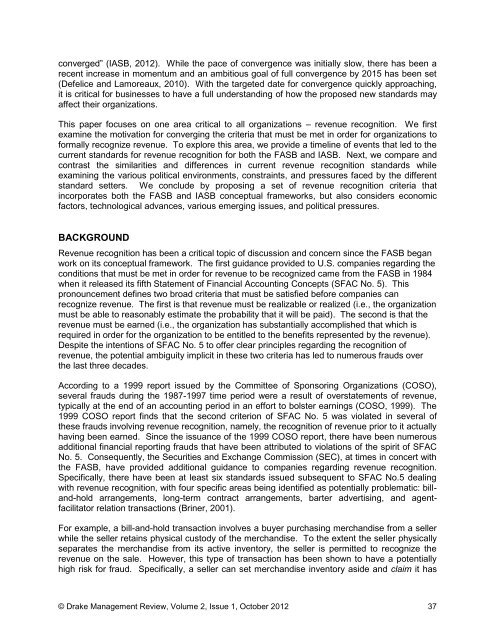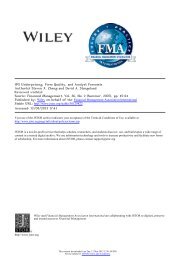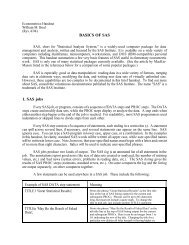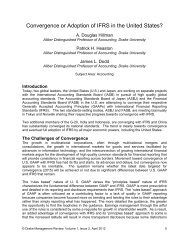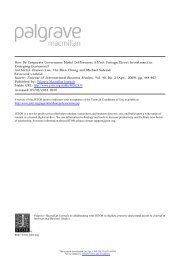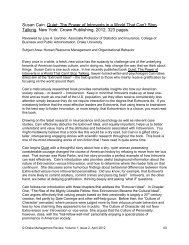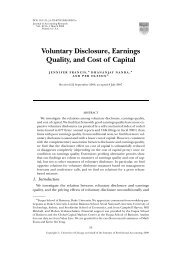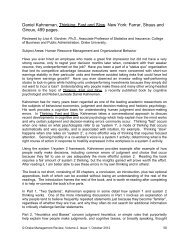IASB & FASB Convergence Project - Drake College of Business and ...
IASB & FASB Convergence Project - Drake College of Business and ...
IASB & FASB Convergence Project - Drake College of Business and ...
You also want an ePaper? Increase the reach of your titles
YUMPU automatically turns print PDFs into web optimized ePapers that Google loves.
converged” (<strong>IASB</strong>, 2012). While the pace <strong>of</strong> convergence was initially slow, there has been arecent increase in momentum <strong>and</strong> an ambitious goal <strong>of</strong> full convergence by 2015 has been set(Defelice <strong>and</strong> Lamoreaux, 2010). With the targeted date for convergence quickly approaching,it is critical for businesses to have a full underst<strong>and</strong>ing <strong>of</strong> how the proposed new st<strong>and</strong>ards mayaffect their organizations.This paper focuses on one area critical to all organizations – revenue recognition. We firstexamine the motivation for converging the criteria that must be met in order for organizations t<strong>of</strong>ormally recognize revenue. To explore this area, we provide a timeline <strong>of</strong> events that led to thecurrent st<strong>and</strong>ards for revenue recognition for both the <strong>FASB</strong> <strong>and</strong> <strong>IASB</strong>. Next, we compare <strong>and</strong>contrast the similarities <strong>and</strong> differences in current revenue recognition st<strong>and</strong>ards whileexamining the various political environments, constraints, <strong>and</strong> pressures faced by the differentst<strong>and</strong>ard setters. We conclude by proposing a set <strong>of</strong> revenue recognition criteria thatincorporates both the <strong>FASB</strong> <strong>and</strong> <strong>IASB</strong> conceptual frameworks, but also considers economicfactors, technological advances, various emerging issues, <strong>and</strong> political pressures.BACKGROUNDRevenue recognition has been a critical topic <strong>of</strong> discussion <strong>and</strong> concern since the <strong>FASB</strong> beganwork on its conceptual framework. The first guidance provided to U.S. companies regarding theconditions that must be met in order for revenue to be recognized came from the <strong>FASB</strong> in 1984when it released its fifth Statement <strong>of</strong> Financial Accounting Concepts (SFAC No. 5). Thispronouncement defines two broad criteria that must be satisfied before companies canrecognize revenue. The first is that revenue must be realizable or realized (i.e., the organizationmust be able to reasonably estimate the probability that it will be paid). The second is that therevenue must be earned (i.e., the organization has substantially accomplished that which isrequired in order for the organization to be entitled to the benefits represented by the revenue).Despite the intentions <strong>of</strong> SFAC No. 5 to <strong>of</strong>fer clear principles regarding the recognition <strong>of</strong>revenue, the potential ambiguity implicit in these two criteria has led to numerous frauds overthe last three decades.According to a 1999 report issued by the Committee <strong>of</strong> Sponsoring Organizations (COSO),several frauds during the 1987-1997 time period were a result <strong>of</strong> overstatements <strong>of</strong> revenue,typically at the end <strong>of</strong> an accounting period in an effort to bolster earnings (COSO, 1999). The1999 COSO report finds that the second criterion <strong>of</strong> SFAC No. 5 was violated in several <strong>of</strong>these frauds involving revenue recognition, namely, the recognition <strong>of</strong> revenue prior to it actuallyhaving been earned. Since the issuance <strong>of</strong> the 1999 COSO report, there have been numerousadditional financial reporting frauds that have been attributed to violations <strong>of</strong> the spirit <strong>of</strong> SFACNo. 5. Consequently, the Securities <strong>and</strong> Exchange Commission (SEC), at times in concert withthe <strong>FASB</strong>, have provided additional guidance to companies regarding revenue recognition.Specifically, there have been at least six st<strong>and</strong>ards issued subsequent to SFAC No.5 dealingwith revenue recognition, with four specific areas being identified as potentially problematic: bill<strong>and</strong>-holdarrangements, long-term contract arrangements, barter advertising, <strong>and</strong> agentfacilitatorrelation transactions (Briner, 2001).For example, a bill-<strong>and</strong>-hold transaction involves a buyer purchasing merch<strong>and</strong>ise from a sellerwhile the seller retains physical custody <strong>of</strong> the merch<strong>and</strong>ise. To the extent the seller physicallyseparates the merch<strong>and</strong>ise from its active inventory, the seller is permitted to recognize therevenue on the sale. However, this type <strong>of</strong> transaction has been shown to have a potentiallyhigh risk for fraud. Specifically, a seller can set merch<strong>and</strong>ise inventory aside <strong>and</strong> claim it has© <strong>Drake</strong> Management Review, Volume 2, Issue 1, October 2012 37


